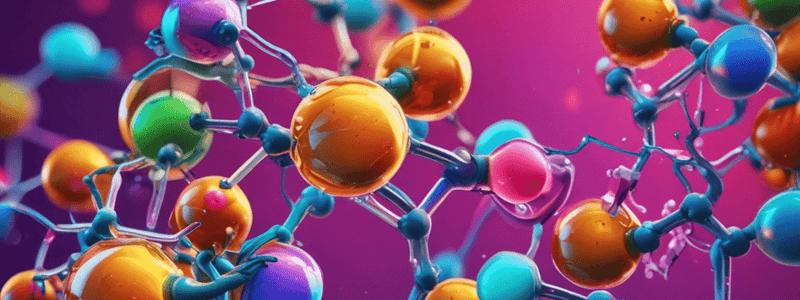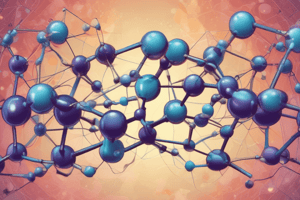Podcast
Questions and Answers
How does pyridine behave towards electrophilic substitution?
How does pyridine behave towards electrophilic substitution?
- Does not undergo any electrophilic substitution (correct)
- Similar to benzene
- Highly reactive under mild conditions
- Forms stable carbonium ions
In which position does substitution mainly occur in pyridine during electrophilic reactions?
In which position does substitution mainly occur in pyridine during electrophilic reactions?
- 3- position (correct)
- 4- position
- 2- position
- 1- position
What type of reactions involve pyridine acting as a base or nucleophile?
What type of reactions involve pyridine acting as a base or nucleophile?
- Nucleophilic substitution
- Electrophilic substitution
- Substitution involving nitrogen directly (correct)
- Friedel-Crafts reaction
Which statement best describes pyridine's reactivity towards various aromatic ring substitutions?
Which statement best describes pyridine's reactivity towards various aromatic ring substitutions?
Why does pyridine not undergo the Friedel-Crafts reaction?
Why does pyridine not undergo the Friedel-Crafts reaction?
How does the nitrogen atom in pyridine affect its reactions?
How does the nitrogen atom in pyridine affect its reactions?
Which of the following statements about the carbonium ion formed by attacking pyridine at the 4-position is correct?
Which of the following statements about the carbonium ion formed by attacking pyridine at the 4-position is correct?
Which of the following statements about the carbonium ion formed by attacking pyridine at the 3-position is correct?
Which of the following statements about the carbonium ion formed by attacking pyridine at the 3-position is correct?
Which of the following statements about the carbonium ion formed by attacking pyridine at the 2-position is correct?
Which of the following statements about the carbonium ion formed by attacking pyridine at the 2-position is correct?
Which of the following statements about the stability of the carbonium ions formed in pyridine compared to benzene is correct?
Which of the following statements about the stability of the carbonium ions formed in pyridine compared to benzene is correct?
Which of the following statements about the substitution reaction in pyridine is correct?
Which of the following statements about the substitution reaction in pyridine is correct?
Which of the following statements about the predominant substitution position in pyridine is correct?
Which of the following statements about the predominant substitution position in pyridine is correct?
Why is a structure with a positive charge on nitrogen especially stable for pyrrole?
Why is a structure with a positive charge on nitrogen especially stable for pyrrole?
Why is a structure with a positive charge on nitrogen especially unstable for pyridine?
Why is a structure with a positive charge on nitrogen especially unstable for pyridine?
Why can 2-aminopyridine be nitrated or sulfonated under milder conditions than pyridine itself?
Why can 2-aminopyridine be nitrated or sulfonated under milder conditions than pyridine itself?
Why does substitution in 2-aminopyridine occur chiefly at the 5-position?
Why does substitution in 2-aminopyridine occur chiefly at the 5-position?
Why is 3-aminopyridine most conveniently made via nicotinic acid?
Why is 3-aminopyridine most conveniently made via nicotinic acid?
What is the key step in the synthesis of 3-aminopyridine from $\beta$-picoline?
What is the key step in the synthesis of 3-aminopyridine from $\beta$-picoline?
Why does pyridine undergo substitution more slowly than benzene?
Why does pyridine undergo substitution more slowly than benzene?
Why is attack at the 4-position particularly slow in pyridine?
Why is attack at the 4-position particularly slow in pyridine?
How does the substitution behavior of pyridine differ from that of pyrrole?
How does the substitution behavior of pyridine differ from that of pyrrole?
What characterizes the stability of carbonium ions formed in pyridine compared to those formed in benzene?
What characterizes the stability of carbonium ions formed in pyridine compared to those formed in benzene?
Why does substitution occur predominantly at the 3-position in pyridine?
Why does substitution occur predominantly at the 3-position in pyridine?
What distinguishes substitution behavior between ortho and para attack in pyridine?
What distinguishes substitution behavior between ortho and para attack in pyridine?
Which nitrogen-containing heterocycle forms a structure with a positive charge on nitrogen that is especially stable due to every atom having an octet of electrons?
Which nitrogen-containing heterocycle forms a structure with a positive charge on nitrogen that is especially stable due to every atom having an octet of electrons?
Why is a structure with a positive charge on nitrogen especially unstable for pyridine compared to pyrrole?
Why is a structure with a positive charge on nitrogen especially unstable for pyridine compared to pyrrole?
Why can 2-aminopyridine be nitrated or sulfonated under milder conditions than pyridine itself?
Why can 2-aminopyridine be nitrated or sulfonated under milder conditions than pyridine itself?
What is the most convenient precursor to synthesize 3-aminopyridine?
What is the most convenient precursor to synthesize 3-aminopyridine?
Why is the structure with a positive charge on nitrogen especially stable in pyrrole?
Why is the structure with a positive charge on nitrogen especially stable in pyrrole?
Which of the following statements best explains the preferential substitution at the 3-position in pyridine during electrophilic reactions?
Which of the following statements best explains the preferential substitution at the 3-position in pyridine during electrophilic reactions?
Which of the following statements accurately describes the reactivity of pyridine towards electrophilic substitution reactions compared to benzene?
Which of the following statements accurately describes the reactivity of pyridine towards electrophilic substitution reactions compared to benzene?
Which of the following statements best explains why pyridine does not undergo the Friedel-Crafts reaction?
Which of the following statements best explains why pyridine does not undergo the Friedel-Crafts reaction?
In the electrophilic substitution of pyridine, which of the following statements accurately describes the stability of the carbonium ion intermediates formed at different positions compared to those formed in benzene?
In the electrophilic substitution of pyridine, which of the following statements accurately describes the stability of the carbonium ion intermediates formed at different positions compared to those formed in benzene?
Which of the following statements accurately describes the role of the nitrogen atom in pyridine during reactions involving it as a base or nucleophile?
Which of the following statements accurately describes the role of the nitrogen atom in pyridine during reactions involving it as a base or nucleophile?
Which of the following statements accurately describes the effect of substituting pyridine with an electron-withdrawing group, such as a nitro group, on its reactivity towards electrophilic substitution?
Which of the following statements accurately describes the effect of substituting pyridine with an electron-withdrawing group, such as a nitro group, on its reactivity towards electrophilic substitution?
Flashcards are hidden until you start studying
Study Notes
Electrophilic Substitution in Pyridine
- Pyridine mainly undergoes electrophilic substitution at the 3-position, due to the nitrogen's electron-withdrawing property.
- Electrophilic substitution is slower in pyridine compared to benzene, as the aromaticity is disrupted by the nitrogen atom.
- Pyridine does not undergo Friedel-Crafts reactions because the nitrogen atom coordinates with the Lewis acid, preventing the formation of an active electrophile.
Role of Nitrogen in Pyridine
- The nitrogen atom in pyridine acts as an electron-withdrawing group, stabilizing the aromatic system but hindering electrophilic attack.
- Due to its electronegativity, the nitrogen atom causes a positive charge, which is particularly unstable when formed in pyridine compared to pyrrole.
Stability of Carbonium Ions
- Carbonium ions formed at the 2-, 3-, and 4-positions in pyridine have different stabilities, with 4-position being especially slow due to steric hindrance and electronic effects.
- Carbonium ions in pyridine are generally less stable than those formed in benzene, which can delocalize positive charge over multiple carbons.
Substitution Reactions with Aminopyridines
- 2-aminopyridine can undergo nitration or sulfonation under milder conditions due to the activating effect of the amino group at the 5-position.
- Substitution in 2-aminopyridine is predominantly at the 5-position because the amino group directs electrophiles to this site more effectively.
Synthesis Insights
- 3-aminopyridine is most conveniently synthesized from nicotinic acid, providing a straightforward synthetic pathway.
- The key step in synthesizing 3-aminopyridine from β-picoline involves a simple amination reaction that favors the desired substitution.
Comparative Reactivity
- Pyridine shows different reactivity towards ortho and para attacks compared to benzene, with predominant 3-position substitution creating distinct challenges.
- Structures with a positive charge on nitrogen are particularly stable in pyrrole due to electron delocalization, contrasting with pyridine’s instability under similar conditions.
Conclusion on Reactivity
- Pyridine's reactivity towards electrophilic substitution is altered by substituents such as electron-withdrawing groups (e.g., nitro groups), which further decrease its reactivity.
- Overall, the unique structure of pyridine leads to distinct behaviors in substitution reactions compared to typical aromatic compounds like benzene.
Studying That Suits You
Use AI to generate personalized quizzes and flashcards to suit your learning preferences.



